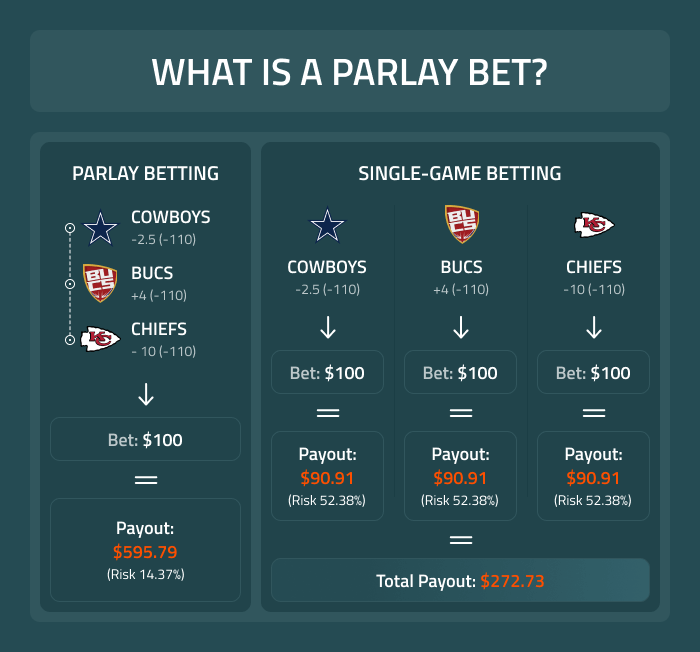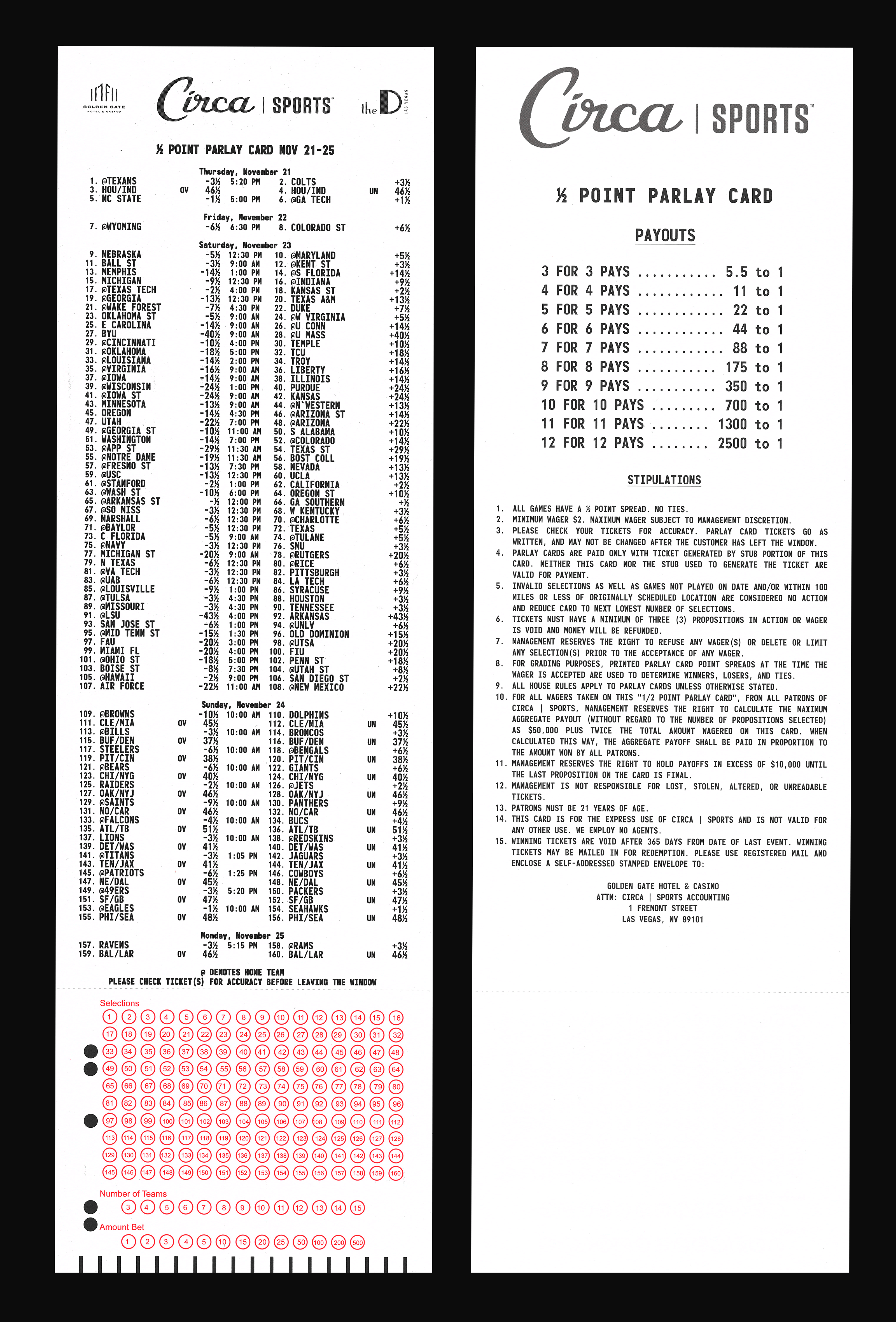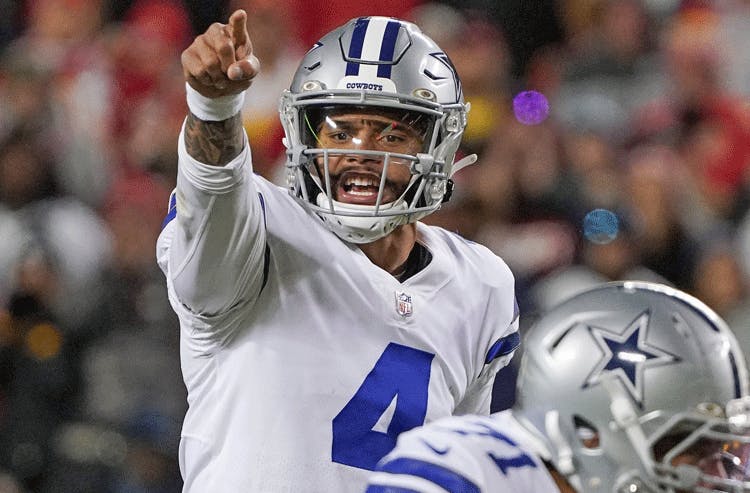What is a parlay?
A parlay is one wager on two or more bets that are tied together for a larger payout. For the parlay to win, all bets involved must win. The more bets added to the parlay, the greater the risk and the bigger the payout. If a single bet in the parlay loses, the entire parlay bet loses as well.
How does a parlay work?
Parlays tie together multiple bets and because all the bets involved must win for the parlay to pay out, the risk is much higher than a single-game bet. However, that increased risk is reflected in the parlay odds.
3-team parlay
As an example, this is a three-team NFL parlay. The parlay involves three spread bets: the Dallas Cowboys -2.5, the Tampa Bay Buccaneers +4, and the Kansas City Chiefs -10.
In order for this three-team parlay to win, the Chiefs must win by at least 11 points, the Cowboys must win by at least three points, and the Buccaneers must win outright or lose by less than four points. Even if two of these three bets win and only one loses, the overall parlay loses.

Parlay odds
Parlay odds can be calculated by dividing the total return amount (win + wager) by the wager amount to get a decimal multiplier (also known as European odds) for each bet involved in the parlay. Then you times those multipliers by each other to get the parlay odds.
For example, a three-team moneyline parlay involves bets of -120, -130, and +115.
If you’re wagering $100 on the parlay, you should have multipliers of 1.83, 1.77, and 2.15 for those individual bets. Multiplying those odds gives you 6.96 and with a $100 wager on the parlay, the total return would be $696 (6.96 x $100) – a win of $596.
What are the odds of hitting a parlay?
Parlay betting is a high-risk, high-reward wager and the more bets involved the slimmer the odds of hitting the parlay.
Using the standard -110 vig for point spread and totals bets, these are the odds of winning your parlay based on the number of bets involved:
- Two-team parlay – 27.47 percent
- Three-team parlay – 14.37 percent
- Four-team parlay – 7.52 percent
- Five-team parlay – 3.94 percent
- Six-team parlay – 2.06 percent
- Seven-team parlay – 1.08 percent
- Eight-team parlay – 0.56 percent
- Nine-team parlay – 0.30 percent
- 10-team parlay – 0.15 percent
Parlay payouts
The size of your parlay payout depends on how many bets are involved and the individual odds for those bets.
Using standard -110 vig for point spread and totals, these are the parlay payouts for a $100 wager:
- Two-team parlay - $264.46
- Three-team parlay - $595.79
- Four-team parlay - $1,228.33
- Five-team parlay - $2,435.90
- Six-team parlay - $4,741.27
- Seven-team parlay - $9,142.43
- Eight-team parlay - $17,544.64
- Nine-team parlay - $33,585.23
- 10-team parlay - $64,208.16
Payouts will increase and decrease with the number of games added to the parlay but also with the varying odds for those bets. A moneyline parlay involving heavy payouts will not pay out as much as one involving underdogs because the risk isn’t as great.
Use our parlay calculator to build your best parlay picks and calculate how much money you could win.
Push on a parlay
If one of the bets involved in a parlay is graded as a push or tie, the bet is removed from the parlay and it’s graded on the remaining bets.
If a three-team parlay has two bets correct and one graded as a push, the bet that pushed is removed and the parlay is then graded as a two-team parlay and the payouts are adjusted to reflect the risk of the two correct bets.
Round robin parlays
Round robin parlays allow multiple parlays to be placed across several games. Bettors can choose multiple bets and then create parlays of various sizes involving those games, with each parlay variation requiring an individual wager.
For example, a four-team round-robin parlay can include parlays of two, three, and four teams. Any possible combination of winning bets that fits those parlays will pay out, however, you must place individual wagers on the 11 different parlay combinations.
Parlay cards
Many sportsbooks, especially those retail books inside casinos, will use a standard set of odds to determine parlay payouts. Football parlay cards are very popular on NFL Sundays, as casual bettors look to risk a little to win a lot of money.

Parlay card payouts
Instead of the parlay odds calculations shown above, parlay cards offer a set payout amount for point spread and Over/Under parlays:
- Three-team parlay - 5.5/1
- Four-team parlay - 11/1
- Five-team parlay - 22/1
- Six-team parlay - 44/1
- Seven-team parlay - 88/1
- Eight-team parlay 175/1
- Nine-team parlay - 350/1
- 10-team parlay - 700/1
- 11-team parlay - 1,300/1
- 12-team parlay - 2,500/1
Parlay betting FAQ
In terms of win probability, a parlay isní»t a good bet when compared to single-game wagers.
A $100 three-team parlay (-110 odds for each game) will pay $595.79.
Yes, some sportsbooks will allow you to parlay prop bets.
A key parlay involves one bet that is used in multiple parlays.
You can not use the same bet twice in a parlay. You can, however, parlay the spread or moneyline and Over/Under total from the same game.
Every parlay is risky, and the chances of winning will differ. If just one of your games doesn't go your way, you lose the parlay.
By their nature, parlays are high-risk, high-reward bets. If you win one, your payout would be higher than if you had bet the parlay legs separately.
Making smart straight bets will help with long-term winning, but betting a well-constructed parlay could payout big for you in the short-term, but in the long run, they are less likely to provide profit.
Making smart straight bets will help with long-term winning, but betting a well-constructed parlay could payout big for you in the short-term, but in the long run, they are less likely to provide profit.
If your sportsbook allows you to cash out on in-play parlays, you can cash out when you feel you've profited and may not feel great about that final leg.
Yes, people can win big on parlays, which are single bets that link together multiple individual bets. Because of the cumulative nature of the odds, parlays can provide high payouts if all the individual bets are won. However, it's important to note that parlays are also much harder to win because if even one of the linked bets loses, you lose the entire parlay. This makes them a riskier choice compared to single bets. As always, ití»s important to bet responsibly and within your personal financial limits.
The chances of winning a 3-game parlay depend on the odds of each individual game. However, if we assumed each bet was a coin flip with a 50% chance of winning, the probability of winning all three bets in the parlay would be 0.5 * 0.5 * 0.5 = 0.125, or 12.5%. This simplification assumes each game is independent and equally likely to go either way, but keep in mind that actual sports contests are influenced by many factors and are not 50/50 propositions. So, the real-world probability could be higher or lower depending on the specifics of each game in the parlay.
Deciding when to cash out a parlay depends on your confidence in remaining picks, the risk versus reward balance, and the cash-out value offered. If you believe your remaining picks will win, it might be worth letting the parlay continue. If risk seems high for the remaining games, cashing out to secure some profit could be a wise move. Lastly, consider the cash-out value offered, especially if it's significantly lower than potential winnings. Always ensure to bet responsibly.




















